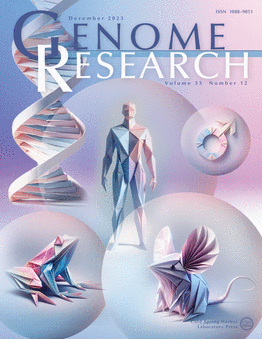人类疾病表型的进化新基因揭示了适应性创新和性选择形成的功能富集模式
IF 6.2
2区 生物学
Q1 BIOCHEMISTRY & MOLECULAR BIOLOGY
引用次数: 0
摘要
新基因(或年轻基因)是哺乳动物进化过程中至关重要的遗传新事物。然而,由于功能研究的技术和伦理复杂性,它们的表型影响和进化模式在人类中仍然难以捉摸。将基因年龄定年与孟德尔疾病表型相结合,我们发现随着基因年龄的增加,疾病基因比例逐渐上升。逻辑回归模型表明,老年基因的增加可能与它们更长的序列长度和更高的有害新生种系变异(dnv)负担有关。我们还发现,在宏观进化时间尺度上,具有生物医学表型的新基因稳定地整合到人类基因组中(每百万年约0.07%)。尽管这种稳定的速度,我们观察到不同基因年龄的表型富集、多效性和选择压力的不同模式。年轻基因在与男性生殖系统相关的疾病中表现出显著的富集,表明强烈的性选择。年轻基因还表现出与疾病相关的功能,这些功能可能与人类表型创新有关,例如大脑体积增大、肌肉骨骼表型和色觉。我们进一步揭示了多效性在进化过程中的逻辑增长模式,表明随着时间的推移,由于选择性约束的加剧,旧基因的新功能的边际增长正在减少。我们提出了一个“多效性屏障”模型,该模型描述了年轻基因比年老基因具有更高的表型创新潜力,这是自然选择下的一个过程。我们的研究表明,进化上的新基因对于影响人类生殖进化和由性选择和自然选择驱动的适应性表型创新至关重要,低多效性是一种选择优势。本文章由计算机程序翻译,如有差异,请以英文原文为准。
Evolutionarily new genes in humans with disease phenotypes reveal functional enrichment patterns shaped by adaptive innovation and sexual selection
New genes (or young genes) are genetic novelties pivotal in mammalian evolution. However, their phenotypic impacts and evolutionary patterns over time remain elusive in humans due to the technical and ethical complexities of functional studies. Integrating gene age dating with Mendelian disease phenotyping, we reveal a gradual rise in disease gene proportion as gene age increases. Logistic regression modeling indicates that this increase in older genes may be related to their longer sequence lengths and higher burdens of deleterious de novo germline variants (DNVs). We also find a steady integration of new genes with biomedical phenotypes into the human genome over macroevolutionary timescales (~0.07% per million years). Despite this stable pace, we observe distinct patterns in phenotypic enrichment, pleiotropy, and selective pressures across gene ages. Young genes show significant enrichment in diseases related to the male reproductive system, indicating strong sexual selection. Young genes also exhibit disease-related functions potentially linked to human phenotypic innovations, such as increased brain size, musculoskeletal phenotypes, and color vision. We further reveal a logistic growth pattern of pleiotropy over evolutionary time, indicating a diminishing marginal growth of new functions for older genes due to intensifying selective constraints over time. We propose a "pleiotropy-barrier" model that delineates higher potentials for phenotypic in-novation in young genes compared to older genes, a process under natural selection. Our study demonstrates that evolutionarily new genes are critical in influencing human reproductive evolution and adaptive phenotypic innovations driven by sexual and natural selection, with low pleiotropy as a selective advantage.
求助全文
通过发布文献求助,成功后即可免费获取论文全文。
去求助
来源期刊

Genome research
生物-生化与分子生物学
CiteScore
12.40
自引率
1.40%
发文量
140
审稿时长
6 months
期刊介绍:
Launched in 1995, Genome Research is an international, continuously published, peer-reviewed journal that focuses on research that provides novel insights into the genome biology of all organisms, including advances in genomic medicine.
Among the topics considered by the journal are genome structure and function, comparative genomics, molecular evolution, genome-scale quantitative and population genetics, proteomics, epigenomics, and systems biology. The journal also features exciting gene discoveries and reports of cutting-edge computational biology and high-throughput methodologies.
New data in these areas are published as research papers, or methods and resource reports that provide novel information on technologies or tools that will be of interest to a broad readership. Complete data sets are presented electronically on the journal''s web site where appropriate. The journal also provides Reviews, Perspectives, and Insight/Outlook articles, which present commentary on the latest advances published both here and elsewhere, placing such progress in its broader biological context.
 求助内容:
求助内容: 应助结果提醒方式:
应助结果提醒方式:


